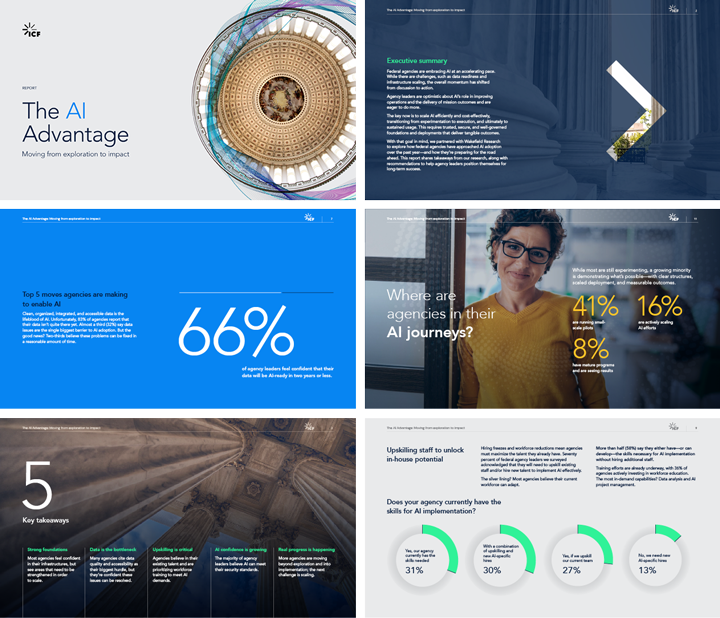
Empowering the Office of Child Care's critical mission through rapid digital transformation
ICF guided The Office of Child Care (OCC) through a digital transformation that reconciled workflow hurdles to better achieve client outcomes. The modernization strategy leveraged technology, effective change management, and training and technical assistance best practices.
In partnership with ICF and ServiceNow, OCC was able to redesign their technical assistance tracking solution to meet new requirements and address evolving user needs.
Challenge
The OCC, part of the U.S. Department of Health and Human Services, supports American families through access to affordable, high-quality early care and afterschool programs. The program’s technical assistance (TA) tracker—known as the TAT system and used to track the TA activities delivered by national centers to grantees—required updating to maximize efficiency and keep pace with evolving requirements.
As the TAT system was built in late 2012, current users found it increasingly difficult to navigate due to taxonomy bloat and fields that had grown irrelevant over time. The cumbersome experience led users to avoid the tool altogether, causing workflows to happen outside the tool—which, in turn, led to inconsistent processes, data collection, and reporting.
Additionally, since the tool’s original launch, government requirements for security and various digital compliance had changed. The new operating environment demanded a rebuild of the old TAT system to be more compliant, integration capable, require less technical maintenance, provide more robust reporting, and better serve user needs—saving people time and increasing oversight efficiency.
- Human-centered design
- Cloud
- Low-code/No-code
- Scaled Agile
- DevSecOps
Solution
When modernizing workflows, it’s not enough to replace or rebuild outdated technology. Digital transformations often fail due to a cultural resistance to change—as found in our latest digital transformation report—compounded by an absence of insight from the tactical and operational users of the tool. It’s vital to design solutions with end users in mind to ensure adoption and set the stage for an effective transformation.
ICF formed an interdisciplinary team consisting of relevant subject matter experts from our public health, public sector, digital transformation, and digital agency practices. Before considering the technology stack, we took a human-centered design (HCD) approach and conducted primary research on the legacy tool’s workflow pain points and gaps, as well as discovery on overall user needs for the new system.
That research—consisting of current user interviews—allowed us to form user stories, descriptions, and design guidelines and begin to articulate concepts to government stakeholders. Understanding that requirements emerge and evolve over time, the user stories acted as a starting point, covering system architecture, content, design, reporting, workflow, and governance requirements. They allowed our user experience (UX) team to create as-is vs. to-be user flow maps that were crucial in evaluating an appropriate technology solution.
After careful consideration, ICF determined that ServiceNow—a FedRAMP authorized, cloud-based, platform-as-a-service leveraged for low-code implementations—would best fit the requirements of the new tool. ICF developed a deeper understanding of the OCC and the legacy TAT tool through user research, including interviews to identify pain points and understand user journeys. Harnessing that expanded understanding along with our development expertise across multiple technologies and platforms, ICF implemented a ServiceNow-based solution that provided optimal flexibility, launch speed, and an ideal cost profile to achieve the intended performance outcomes for the Administration for Children and Families (ACF) team.
Results
By surfacing ideas through a human-centered design approach and then using agile, lean, and DevOps principles to drive them forward, we were able to create a new technical assistance solution that streamlines user experience and provides more enhanced reporting capabilities to the government—while also ensuring continuity of operations by enabling the migration of existing TAT data from the legacy TAT application.
The TAT redesign was further made possible by our clearly structured content and design components that informed the development process, which itself was accelerated by using ServiceNow. ServiceNow’s Customer Service Management (CSM) module acted as the baseline solution for OCC’s TA modernization initiative, and its out-of-the-box and low-code-no-code capabilities rapidly improved OCC’s ability to drive information collection, management, dissemination, and reporting. Additionally, ICF’s use of ServiceNow’s fully FedRAMP-certified Platform as a Service (PaaS) offering made it easier for OCC to satisfy HHS and ACF security requirements and attain an Authority to Operate (ATO) for the TAT solution.
“With a renewed focus across federal to improve customer service within the business of government, modern technology is essential to delivering better, faster government services... Customer Service Management (CSM)...connects the customer to the agency with omnichannel experiences and removes silos by aligning the front, back, and middle offices to dramatically improve SLA’s and processes for the case workers, providing a best-in-class solution for both the customer and the Agency.”
ICF ensured that implementation of innovative features was controlled and tracked through an effective change management approach. That approach included multiple points of communication and training—ensuring buy-in from all users of the application. After go-live, we continue to add enhancements to TAT that drive further efficiencies for all users of the tool, and have seen an increase in empowered super users customizing reports, dashboard views, and TA process outputs. That has enabled OCC users to make data-driven decisions while also improving efficiency around data entry and tracking.
By combining our domain insight, the power of UX research and design, system development expertise along with an enabling low-code platform, we were able to help the OCC revamp a critical tool in the service of mission outcomes.
Related industries, and services
